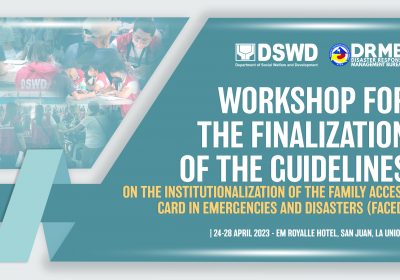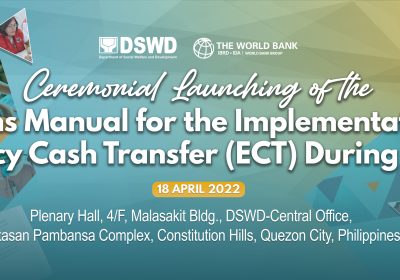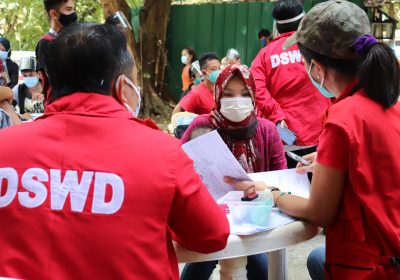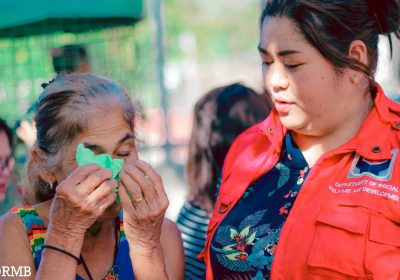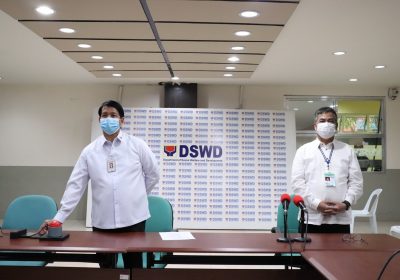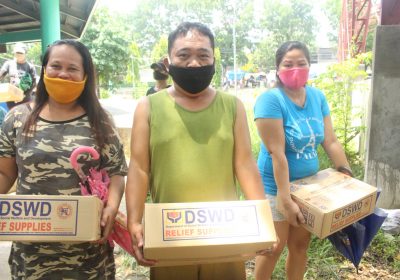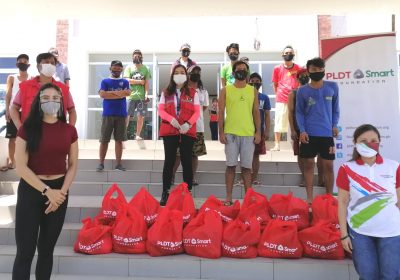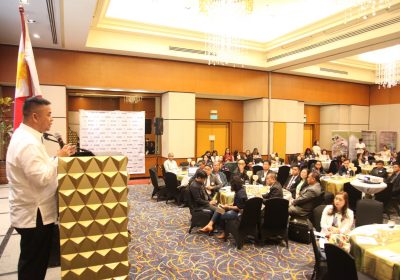Chapter I:
“Not Too Long Ago: DSWD Disaster Response Story as of 2010”
The Disaster Response Assistance and Management Bureau (DReAMB) evolved from one of the divisions of the Protective Management Bureau (now Protective Services Bureau) of the Department of Social Welfare and Development (DSWD). The Division 3 then was engaged in disaster management operations, monitoring and special concerns. It was organized with four (4) units, namely: Preparedness, Response, Rehabilitation, and Disaster Response Operations Monitoring and Information Center (DROMIC) and consisting of 20 personnel under a Division Chief. The function of Division 3 includes disaster response operations with focus on food and non-food items (FNFI), camp coordination and camp management (CCCM), and Internally Displaced Person (IDP) Protection. The provision of family food packs (FFPs) and non-food items, Cash-/Food-for-Work (C/FFW), Emergency Shelter Assistance (ESA), and Core/Modified Shelter Assistance Program (C/MSAP) were part of its program deliverables.
In 2012, DSWD Memorandum Circular (MC) No. 1 series of 2012 was issued and placed the disaster-related response portfolio to the Risk Reduction and Management Program Division of the Protective Services Bureau. As disasters increased in number and magnitude, so did the tasks and scope of the division.
In that same year, said issuance was amended through DSWD MC No. 25 series of 2012 to internally create the Disaster Risk Reduction and Response Operations Office (DRRROO), as a separate and distinct office handling the Warehouse Management and Donation Facilitation Division and the Disaster Risk Reduction and Management Division.
Massive disasters, both natural and human-induced, occurred towards the end of 2013; armed conflict in Zamboanga City, earthquake in Central Visayas devastating a large area of Bohol and Cebu, and Super Typhoon Yolanda that affected millions of families.
In the second quarter of 2014 due to the high demand for disaster related information, the DROMIC was placed under the supervision of Assistant Secretary of the Office of the Secretary and expanded the functions of disaster operations monitoring and reports. The DRRROO, on the other hand, continued under the Operations and Programs Group and focused on disaster response operations.
The reclustering of Offices, Bureaus, Services and Units (OBSUs) at the DSWD Central Office through the issuance of DSWD Administrative Order (AO) No. 2 series of 2015 ensued the inception of DReAMB to enhance its disaster response initiatives that would focus on Disaster Risk Reduction and Management (DRRM) programs, activities and projects of the Department. The DRRROO and DROMIC were once again merged together and formed part of the new bureau, while the Warehouse Management and Donation Facilitation Division was transferred to the National Resource Operations Office (NROO) under the General Administration and Support Services Group (GASSG).
Chapter II:
“After Six Years: Evolution of DReAMB Story by 2016”
It has been evident that the DReAMB started small as a division and became an integral part of the Department as it transitioned and transformed into a bureau delivering its mandate on protecting the vulnerable sectors especially during emergencies.
The Department established its protocols and levels of disaster response operations through an internal administrative issuance, the DSWD AO No. 3 series of 2015: Disaster Response Operations Guidelines. This was developed to indicate the factors and requirements for an agency-wide response. It also includes the roles and responsibilities of each Office, Bureau, Service and Unit (OBSU) for every alert level.
The DReAMB faced a number of natural and human-induced disasters in the past six years. Among the major disasters are Typhoon Sendong (2011), Typhoon Pablo (2012), Zamboanga Siege (2013), Bohol Earthquake (2013), and Super Typhoon Yolanda (2013). These major disasters contributed and brought changes on how the Department function, improving and enhancing its disaster response operations.
Typhoon Sendong (2011)
Typhoon Sendong affected a total of 118,113 families from regions VII, IX and X. The Department provided a total of ₱59,709,643.57 worth of humanitarian assistance, which includes FFPs and non-food items, to the displaced families. There were 4,458 families with totally damaged houses in safe areas and 5,947 families with partially damaged houses provided with ESA.
There are 6,205 families benefitted from MSAP and now living in disaster-resilient permanent houses in safe zones in the provinces of Misamis Oriental, Lanao del Norte and Bukidnon. The remaining 2,874 shelter units are targeted to be completed and turned over by the end 2016.
The Department also provided CFW to 12,258 individuals and FFW to 201,298 individuals in the cities Cagayan de Oro and Iligan. They were engaged in community works such as repair and construction of shelter units, clearing of debris and surroundings, and cleaning of drainage canals
Typhoon Pablo (2012)
Typhoon Pablo affected a total of 711,682 families where 454,413 families were displaced (64% of the affected families) in Regions IV-B, VI, VII, VIII, IX, X, XI, XII, CARAGA and ARMM identified within the 50 km radius of the typhoon. The Department provided a total of ₱1,677,971,411.00 worth of humanitarian assistance, which includes FFPs and non-food items, to the displaced families. A total of 48,680 families with totally damaged houses in safe areas were provided with ESA.
MSAP was also provided to 29,022 families with totally damaged houses. The remaining 6,461 shelter units are to be completed and turned over by the end of 2016. A total of 406,983 individuals benefitted from the CFW program.
Zamboanga Siege (2013)
It was in 9 September 2016 when the Moro National Liberation Front (MNLF) besieged Zamboanga City, affecting a total of 23,794 families. The Department provided services and interventions amounting to ₱534,304,687.29 to the displaced families. Other assistance such as ESA, financial assistance, transportation assistance, food assistance, bunkhouse repair and CFW were also extended to the families amounting to ₱18,503,944.74. There are 2,720 families currently living in recovery shelters in 12 relocation sites.
Bohol Earthquake (2013)
The 7.2 magnitude earthquake occurred on 15 October 2013 affecting Regions VI and VII. A total of 671,099 families or 3.2 million persons were affected. Of this number, 95,884 families or 465,146 persons were displaced. A total of 42,771 homes were destroyed in 17 hardest hit municipalities in Bohol, with 8,083 totally and 34,688 partially damaged. These municipalities included: Antequera, Balilihan, Buenavista, Calape, Carmen, Catigbian, Clarin, Corella, Cortes, Danao, Inabanga, Loon, Maribojoc, Sagbayan, San Isidro, Sevilla and Tubigon.
The Department provided ₱65,692,711.00 worth of humanitarian assistance to the families displaced by the earthquake. There were 25,924 families provided with ESA. Each family-beneficiary received shelter kit worth ₱10,000.00. there were three (3) construction kit options:
- Timber Kit with Amakan (woven bamboo wall), which included: Amakan, nails, lumber, CGI sheets, steel post brackets, hammer, and saw
- Masonry Kit, which included: cement, sand, gravel, hollow concrete blocks, and tie wire
- Galvanized Iron Roof/Repair Kit, which included: GI sheets, marine plywood, and nails
The CFW program was implemented and 42,610 individuals benefitted from it. These beneficiaries were engaged in agricultural rehabilitation, clearing of debris in the public markets and municipal halls, demolition and clearing operations, construction of damaged houses, house repair and house rebuilding, repair of community facilities, and rehabilitation of roads, water system and dredging of canals.
There are 2,697 families who are beneficiaries of MSAP and now living in houses built to withstand various natural disasters. The remaining 5,535 shelter units will be completed and turned over within 2016.
Super Typhoon Yolanda (2013)
Typhoon Yolanda, with international codename “Haiyan”, affected a total of 1,472,251 families where 918,261 families were displaced (62% of the affected families) in Regions IV-A, IV-B, V, VI, VII, VIII, X, XI and CARAGA identified within the 50 km radius of the typhoon. The Department provided a total of ₱4,418,834,561.70 worth of humanitarian assistance, which includes FFPs with 3kg/6kg of rice and FFPs with 25kg of rice, to families displaced by Typhoon Yolanda.
The Department provided ESA to 462,788 families with totally damaged houses in safe areas and to 640,110 families with partially damaged houses. While, 910 families were provided with CSAP. A total of 66,785 individuals benefitted from CFW program.
Chapter III:
“Post-2016: Reflections Moving Forward”
Key Learning
The leadership of the Department as the Vice-Chair for Disaster Response of the National Disaster Risk Reduction and Management Council (NDRRMC) has brought great contribution as it ensures that the response of the Philippine Government as a whole to disasters is well-coordinated, follows established protocols, and is clearly communicated to the public. This gave the national government confidence in delivering responsive humanitarian assistance to disaster-affected families and communities.
The Department is responsible of activating the Disaster Response Pillar during disaster response operations to monitor and provide immediate response to the needs of the disaster-affected population. It also performs two (2) functions: (1) provides augmentation support to disaster-affected local government units (LGUs) whenever their funds are exhausted and (2) assumes the functions of the LGUs in disaster relief operations depending on the magnitude of the affectation or devastation. Furthermore, it leads three (3) clusters under the Disaster Response Pillar, namely: FNFI, CCCM, and IDP Protection. As lead, it is in-charge in: prepositioning and provision of FNFIs in the affected LGUs; ensuring the availability of safe, secure, and accessible evacuation centers; and, protection of IDPs within the evacuation camps.
However, there is a need to institutionalize the cluster approach down to the FO level in providing assistance to disaster-affected population as introduced by the UN-Humanitarian Agencies. This is to ensure a more coherent and effective response by mobilizing partner government agencies, organizations and non-government organizations (NGOs) to respond in a strategic manner across all key sectors with clearly designated lead agencies in support of the existing government coordination during disaster.
The production and distribution of Disaster Assistance Family Access Cards (DAFACs) to all LGUs through the FOs aims to register all the disaster-affected families nationwide for them to access any assistance that will be provided to them. The DAFAC serves as the basis in masterlisting and profiling of the disaster-affected families per LGU. This will help in minimizing duplication of assistance which will be provided to families and likewise, ensures that nobody will be left behind.
With the “new normal”, the Department has taken the initiative in improving its disaster response operations which include the enhancement of the composition of FFPs, increase in standby funds from ₱1,000,000.00 to ₱3,000,000.00 at each FO, and increase in stockpile of FFPs from 5,000 to 30,000 at each FO and from 10,000 to 100,000 at NROC. It has also established Department-wide Quick Response Teams (QRTs) which shall be activated whenever affected FOs are in need of augmentation support during disaster response operations.
For the past six years, the changes were noteworthy as the disaster response team transitioned from a division to an office and became a bureau. These changes include the improvement of the Information Management Systems, office systems and facilities, became proactive in providing augmentation support to FOs as well as to LGUs, came up with a predictive analytics on humanitarian response, and has strengthened partnership with stakeholders in the delivery of interventions and services to disaster-affected families.
Priorities and Challenges in the Next Six Years
DReAMB recognizes the need to strengthen disaster preparedness for response, take action in anticipation of events, and ensure capacities are in place for effective response and recovery at all levels.
Operational policies and guidelines have implications on the efficacy of disaster response operations and functions of the Department as Vice-Chair of Disaster Response of NDRRMC and lead agency in social protection. Hence, the Department through DReAMB should work closely with all disaster response stakeholders to lead on crafting the Implementing Rules and Regulations (IRR) of the Republic Act (RA) No. 10821 or the Children’s Emergency Relief and Protection Act and the passage of Internally Displaced Protection (IDP) Bill. The development of systems and policies for Emergency Unconditional Cash Transfer is also necessary to address the challenge on accountability and create a mechanism to be applied.
Given the expanding scope of the work of the bureau, the Department NEEDS TO PRIORITIZE the creation of additional mission-critical plantilla positions to staff the divisions. The right-sizing of the quantity and continual development of its human talent is of primordial importance given the realities of having 75% of its workforce are MOA workers. Further, the cascading of the DReAMB organizational template and staff to all Field Offices needs to be prioritized.
Further, DReAMB shall pursue enhanced mechanisms consisting of systems and procedures that will result to the following:
- Enhanced and expanded information management policies and systems (capturing-processing-reporting-storing-sharing) for DROMIC on DSWD sanctioned DRRM functions (Disaster Preparedness, Disaster Response, Early Recovery and Rehabilitation);
- Established capacities and capabilities on Predictive Analysis and Rapid Emergency Telecommunications to pro-actively support timely humanitarian assistance;
- A resilient, fully equipped and staffed Emergency Operations Center facility for disaster situational awareness, predictive humanitarian assistance and disaster response coordination with all DRRM stakeholders; and,
- A lean and mean staffing structure covering the entire DSWD enterprise with a mechanism for surge capacity.
All of these works lead to establishing capacities and capabilities that empower communities and population to be disaster resilient.
